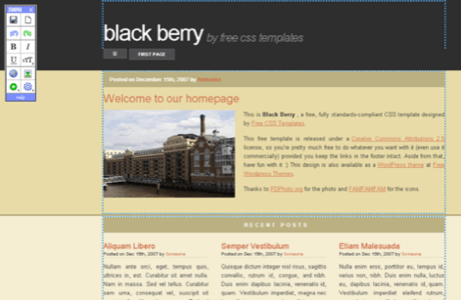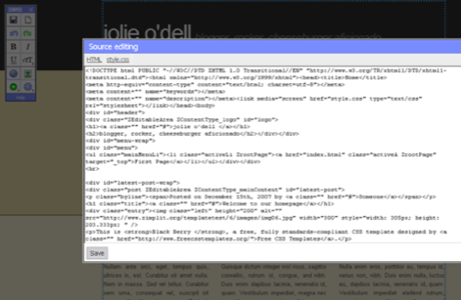Zimplit is the “open source web creation tool for dummies,” according to Mattias Lepp, the company’s executive leader. “Our team doesn’t know anything about the web and software. Oliver Pulges is chemist, Silver Sikk is philologist, and I am old music orchestra conductor. This gives us unique advantage to see and make software for normal people, not for programmers.”

As commerce, socialization, creativity, and identity become increasingly digitized and uploaded, the number of non-technical, “normal people” who need free, simple web design solutions increases. And for allowing non-techies to create quick, customizable, easily editable pages, Zimplit is a good resource. If you’re too skilled for tools like Zimplit, keep it in your back pocket for the next time someone asks you to build a website and you’d really rather not.
Here’s how Zimplit works: The user picks a name and password, a template, and is redirected to a page with text, links, images, and the Zimplit toolbar, a tiny, 12-button wonder with options to redo/undo, modify text settings, add or change links, insert images or other objects, and dive into the source code itself. The page is immediately editable in the browser using the toolbar, no software install required.
It’s simpler still when users choose to buy their own domain, hosting, and email through Zimplit. Otherwise, the Zimplit file needs to be installed on the user’s server of choice.
Here’s a look at the template I chose with the toolbar and the code window:


Using the Zimplit toolbar was instant, and that was awesome. There wasn’t the traditional process of installing and learning the software, creating the files, editing them, saving them, copying to an FTP site, etc. Changes appeared live on the web as they were saved in the Zimplit program.
Editing within the browser was incredibly easy, as well. The Zimplit toolbar is intuitive and simple. It even allowed to me to add YouTube videos, images, and a Google search bar with a single click. There’s also an option to run scripts from the “add items” button in the toolbar.
After a half hour of messing around, this is what I had come up with. It wasn’t earth-shattering, but it was clean and functional. Most importantly, it was quick, easy, and free. We can imagine that nonprofits, individuals, and small businesses with small budgets could turn this into a great tool. If Zimplit were put in the hands of a creative, slightly knowledgeable person with a little more time than I had, he or she could create a sweet little masterpiece.
The Zimplit button was a planned improvement last month from the Zimplit team and ended up being source of some consternation for us. We couldn’t get the button to function as a Firefox or IE add-on; apparently, it would make the editing process even easier, allowing a user to navigate to his live site, click the button, and instantly go into editing mode from the same browser. The mind reels! But as aforementioned, we were unable to test the button ourselves.
As could be reasonably expected with almost any startup offering, the UI is still a bit buggy, with text jumping around or buttons/cursors not working as one might expect. Text selection is weird, and we couldn’t figure out how to delete images or videos we’d inserted without going into the code.
For nondesigners who’d like to play with the templates a bit, it would be nice to have a simple palette tool to change background and text colors. Also, being able to change the font family and size from the toolbar would be great; to make these changes, we had to open up the code window yet again.
On the whole, Zimplit is a great, affordable solution for non-technical folks who need websites. It’s lightweight, and browser-as-website-editor is a fantastic concept in general.
Another point that Lepp emphasized was that the code for Zimplit itself “is incredibly simple. Every HTML enthusiast can make new design templates and widgets for it.” It would be truly great to see a “widget store” for Zimplit, particularly if the widgets were presented in uniform themes and sizes for each web template.
Finally, Zimplit on its website calls itself a content management system; we weren’t able to see those functions. This might be a part of the paid functions to which we didn’t have access.










